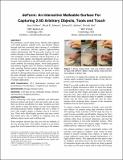| dc.contributor.author | Ishii, Hiroshi | |
| dc.contributor.author | Follmer, Sean Weston | |
| dc.contributor.author | Johnson, Micah K. | |
| dc.contributor.author | Adelson, Edward H | |
| dc.date.accessioned | 2013-08-14T16:40:18Z | |
| dc.date.available | 2013-08-14T16:40:18Z | |
| dc.date.issued | 2011-10 | |
| dc.identifier.isbn | 9781450307161 | |
| dc.identifier.uri | http://hdl.handle.net/1721.1/79860 | |
| dc.description.abstract | We introduce a novel input device, deForm, that supports 2.5D touch gestures, tangible tools, and arbitrary objects through real-time structured light scanning of a malleable surface of interaction. DeForm captures high-resolution surface deformations and 2D grey-scale textures of a gel surface through a three-phase structured light 3D scanner. This technique can be combined with IR projection to allow for invisible capture, providing the opportunity for co-located visual feedback on the deformable surface. We describe methods for tracking fingers, whole hand gestures, and arbitrary tangible tools. We outline a method for physically encoding fiducial marker information in the height map of tangible tools. In addition, we describe a novel method for distinguishing between human touch and tangible tools, through capacitive sensing on top of the input surface. Finally we motivate our device through a number of sample applications. | en_US |
| dc.language.iso | en_US | |
| dc.publisher | Association for Computing Machinery (ACM) | en_US |
| dc.relation.isversionof | http://dx.doi.org/10.1145/2047196.2047265 | en_US |
| dc.rights | Creative Commons Attribution-Noncommercial-Share Alike 3.0 | en_US |
| dc.rights.uri | http://creativecommons.org/licenses/by-nc-sa/3.0/ | en_US |
| dc.source | MIT Web Domain | en_US |
| dc.title | deForm: An interactive malleable surface for capturing 2.5D arbitrary objects, tools and touch | en_US |
| dc.type | Article | en_US |
| dc.identifier.citation | Sean Follmer, Micah Johnson, Edward Adelson, and Hiroshi Ishii. 2011. deForm: an interactive malleable surface for capturing 2.5D arbitrary objects, tools and touch. In Proceedings of the 24th annual ACM symposium on User interface software and technology (UIST '11). ACM, New York, NY, USA, 527-536 | en_US |
| dc.contributor.department | Massachusetts Institute of Technology. Computer Science and Artificial Intelligence Laboratory | en_US |
| dc.contributor.department | Massachusetts Institute of Technology. Department of Brain and Cognitive Sciences | en_US |
| dc.contributor.department | Massachusetts Institute of Technology. Media Laboratory | en_US |
| dc.contributor.department | Program in Media Arts and Sciences (Massachusetts Institute of Technology) | en_US |
| dc.contributor.mitauthor | Follmer, Sean Weston | en_US |
| dc.contributor.mitauthor | Johnson, Micah K. | en_US |
| dc.contributor.mitauthor | Adelson, Edward H. | en_US |
| dc.contributor.mitauthor | Ishii, Hiroshi | en_US |
| dc.relation.journal | Proceedings of the 24th annual ACM symposium on User interface software and technology (UIST '11) | en_US |
| dc.eprint.version | Author's final manuscript | en_US |
| dc.type.uri | http://purl.org/eprint/type/ConferencePaper | en_US |
| eprint.status | http://purl.org/eprint/status/NonPeerReviewed | en_US |
| dspace.orderedauthors | Follmer, Sean; Johnson, Micah; Adelson, Edward; Ishii, Hiroshi | en_US |
| dc.identifier.orcid | https://orcid.org/0000-0003-4918-8908 | |
| dc.identifier.orcid | https://orcid.org/0000-0003-2222-6775 | |
| mit.license | OPEN_ACCESS_POLICY | en_US |
| mit.metadata.status | Complete | |
